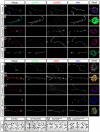Postsynaptic glutamate receptors regulate local BMP signaling at the Drosophila neuromuscular junction
- PMID: 24353060
- PMCID: PMC3879819
- DOI: 10.1242/dev.097758
Postsynaptic glutamate receptors regulate local BMP signaling at the Drosophila neuromuscular junction
Abstract
Effective communication between pre- and postsynaptic compartments is required for proper synapse development and function. At the Drosophila neuromuscular junction (NMJ), a retrograde BMP signal functions to promote synapse growth, stability and homeostasis and coordinates the growth of synaptic structures. Retrograde BMP signaling triggers accumulation of the pathway effector pMad in motoneuron nuclei and at synaptic termini. Nuclear pMad, in conjunction with transcription factors, modulates the expression of target genes and instructs synaptic growth; a role for synaptic pMad remains to be determined. Here, we report that pMad signals are selectively lost at NMJ synapses with reduced postsynaptic sensitivities. Despite this loss of synaptic pMad, nuclear pMad persisted in motoneuron nuclei, and expression of BMP target genes was unaffected, indicating a specific impairment in pMad production/maintenance at synaptic termini. During development, synaptic pMad accumulation followed the arrival and clustering of ionotropic glutamate receptors (iGluRs) at NMJ synapses. Synaptic pMad was lost at NMJ synapses developing at suboptimal levels of iGluRs and Neto, an auxiliary subunit required for functional iGluRs. Genetic manipulations of non-essential iGluR subunits revealed that synaptic pMad signals specifically correlated with the postsynaptic type-A glutamate receptors. Altering type-A receptor activities via protein kinase A (PKA) revealed that synaptic pMad depends on the activity and not the net levels of postsynaptic type-A receptors. Thus, synaptic pMad functions as a local sensor for NMJ synapse activity and has the potential to coordinate synaptic activity with a BMP retrograde signal required for synapse growth and homeostasis.
Keywords: BMP signaling; Drosophila; Glutamate receptor; Glutamatergic synapses; Neuromuscular junction.
Figures







Similar articles
-
Prodomain removal enables neto to stabilize glutamate receptors at the Drosophila neuromuscular junction.PLoS Genet. 2015 Feb 27;11(2):e1004988. doi: 10.1371/journal.pgen.1004988. eCollection 2015. PLoS Genet. 2015. PMID: 25723514 Free PMC article.
-
A Novel, Noncanonical BMP Pathway Modulates Synapse Maturation at the Drosophila Neuromuscular Junction.PLoS Genet. 2016 Jan 27;12(1):e1005810. doi: 10.1371/journal.pgen.1005810. eCollection 2016 Jan. PLoS Genet. 2016. PMID: 26815659 Free PMC article.
-
Drosophila Neto is essential for clustering glutamate receptors at the neuromuscular junction.Genes Dev. 2012 May 1;26(9):974-87. doi: 10.1101/gad.185165.111. Epub 2012 Apr 12. Genes Dev. 2012. PMID: 22499592 Free PMC article.
-
Local BMP signaling: A sensor for synaptic activity that balances synapse growth and function.Curr Top Dev Biol. 2022;150:211-254. doi: 10.1016/bs.ctdb.2022.04.001. Epub 2022 May 18. Curr Top Dev Biol. 2022. PMID: 35817503 Free PMC article. Review.
-
Synaptic homeostats: latent plasticity revealed at the Drosophila neuromuscular junction.Cell Mol Life Sci. 2021 Apr;78(7):3159-3179. doi: 10.1007/s00018-020-03732-3. Epub 2021 Jan 15. Cell Mol Life Sci. 2021. PMID: 33449150 Free PMC article. Review.
Cited by
-
Reactive oxygen species regulate activity-dependent neuronal plasticity in Drosophila.Elife. 2018 Dec 17;7:e39393. doi: 10.7554/eLife.39393. Elife. 2018. PMID: 30540251 Free PMC article.
-
Tissue-specific I-Smad mechanisms revealed by structure-function analysis in Drosophila.bioRxiv [Preprint]. 2025 Jun 25:2025.06.20.660739. doi: 10.1101/2025.06.20.660739. bioRxiv. 2025. PMID: 40666851 Free PMC article. Preprint.
-
Tenectin recruits integrin to stabilize bouton architecture and regulate vesicle release at the Drosophila neuromuscular junction.Elife. 2018 Jun 14;7:e35518. doi: 10.7554/eLife.35518. Elife. 2018. PMID: 29901439 Free PMC article.
-
Neuronal LRP4 directs the development, maturation and cytoskeletal organization of Drosophila peripheral synapses.Development. 2024 Jun 1;151(11):dev202517. doi: 10.1242/dev.202517. Epub 2024 Jun 3. Development. 2024. PMID: 38738619 Free PMC article.
-
RNA-binding FMRP and Staufen sequentially regulate the Coracle scaffold to control synaptic glutamate receptor and bouton development.Development. 2022 May 1;149(9):dev200045. doi: 10.1242/dev.200045. Epub 2022 May 3. Development. 2022. PMID: 35394012 Free PMC article.
References
-
- Aberle H., Haghighi A. P., Fetter R. D., McCabe B. D., Magalhães T. R., Goodman C. S. (2002). wishful thinking encodes a BMP type II receptor that regulates synaptic growth in Drosophila. Neuron 33, 545–558 - PubMed
-
- Adachi-Yamada T., Nakamura M., Irie K., Tomoyasu Y., Sano Y., Mori E., Goto S., Ueno N., Nishida Y., Matsumoto K. (1999). p38 mitogen-activated protein kinase can be involved in transforming growth factor beta superfamily signal transduction in Drosophila wing morphogenesis. Mol. Cell. Biol. 19, 2322–2329 - PMC - PubMed
-
- Ball R. W., Warren-Paquin M., Tsurudome K., Liao E. H., Elazzouzi F., Cavanagh C., An B. S., Wang T. T., White J. H., Haghighi A. P. (2010). Retrograde BMP signaling controls synaptic growth at the NMJ by regulating trio expression in motor neurons. Neuron 66, 536–549 - PubMed
Publication types
MeSH terms
Substances
Grants and funding
LinkOut - more resources
Full Text Sources
Other Literature Sources
Molecular Biology Databases

